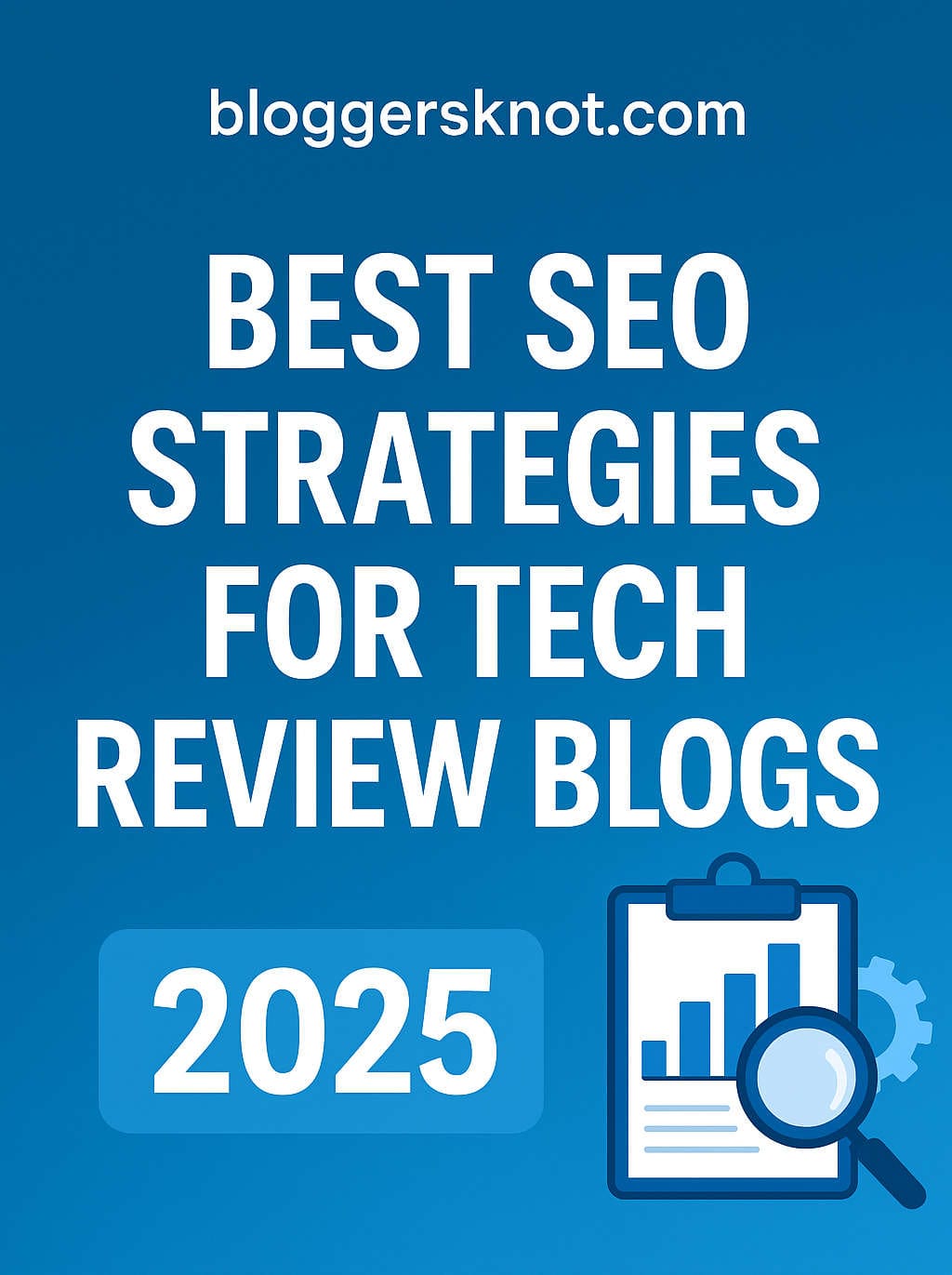Starting a tech review blog is one of the most exciting projects a content creator can undertake. The thrill of testing new gadgets, analyzing software updates, and sharing first-hand experiences is unmatched. But there’s also a harsh reality: the competition is fierce. Established giants like TechRadar, The Verge, and CNET already dominate much of the search engine real estate. To break through that noise, you need more than just enthusiasm—you need a carefully structured, SEO-driven strategy that allows your blog to rank higher, attract the right audience, and build a loyal following.
In this guide, we’ll explore the most effective SEO strategies specifically tailored for tech review blogs. We’ll dive into keyword research, on-page optimization, backlink building, technical improvements, and long-term engagement techniques. Instead of offering you disjointed tips, we’ll take a descriptive, holistic approach that shows you how everything works together. By the end, you’ll have a blueprint to optimize your blog in a way that feels natural, valuable, and sustainable.
Why SEO is Crucial for Tech Review Blogs
The tech blogging space has unique characteristics that make SEO not just helpful, but essential. For one, the speed of innovation in technology is staggering. A new smartphone, laptop, or piece of software may trend for a few months, but then a new release renders your content outdated. That rapid cycle means you need to publish timely content but also balance it with evergreen pieces that remain relevant for years.
Another challenge is the sophistication of your readers. Unlike general lifestyle blogs, the audience for tech reviews often consists of enthusiasts, industry professionals, or consumers making careful buying decisions. These readers demand depth, accuracy, and transparency. If your content lacks authority, they will quickly turn elsewhere.
Finally, monetization for most tech blogs depends heavily on affiliate marketing and ad revenue. Ranking well for high-intent keywords like “best budget gaming laptop 2025” or “iPhone 15 Pro camera review” directly impacts your income. Without SEO, you risk losing out on an audience that is actively searching for what you have to offer.
Building a Strong Keyword Strategy
At the heart of every successful SEO campaign is thoughtful keyword research. For tech bloggers, this process is less about chasing the biggest terms and more about identifying gaps where your content can realistically compete. Big players will dominate broad phrases like “laptop review,” but you can carve out space with more targeted queries.
Long-tail keywords are your best ally. Instead of writing a generic “Samsung Galaxy Review,” consider covering a phrase like “Samsung Galaxy S25 Ultra low-light camera test.” This type of keyword may have less overall search volume, but the traffic it brings is highly relevant and far more likely to engage with your content. Moreover, long-tail queries align closely with real user intent—people typing these searches are actively looking for solutions or reviews.
To discover such opportunities, tools like SEMrush, Ahrefs, and AnswerThePublic are invaluable. They reveal not only the search volume but also related questions people ask. By combining transactional keywords like “best external SSD for video editing” with informational ones such as “what is NVMe storage,” you can strike a balance between educating your audience and capturing high-conversion traffic.
The important point to remember is that keywords are not just for search engines. They should naturally flow into your writing in a way that mirrors how your readers speak and think. When you use them thoughtfully, you help both Google and your audience understand the purpose of your content.
Creating Reviews That Truly Stand Out
When writing tech reviews, the temptation is to cover every new release as quickly as possible. But rushing often leads to thin, repetitive content that adds little value. Google’s algorithms and readers alike now prioritize depth and originality.
A review should feel like an authentic experience. Instead of merely listing specifications, narrate how the product performs in real life. For example, rather than just stating “this phone has a 5,000 mAh battery,” describe how long it lasted during your testing when you streamed video, played games, or used GPS navigation. The more personal and descriptive your content, the more it resonates with readers and establishes trust.
Google also emphasizes what is called E-E-A-T: Experience, Expertise, Authoritativeness, and Trustworthiness. This means you should let your readers know why they should trust your opinion. Share your background with technology, link to other relevant content you’ve written, and avoid overly promotional tones. Transparency—such as acknowledging both the strengths and weaknesses of a product—goes a long way in building authority.
Another overlooked but powerful tool is structured data. By implementing review schema, your posts can display star ratings, prices, or product availability directly in search results. This not only makes your listings stand out but can also boost click-through rates significantly.
On-Page SEO Done Right
On-page optimization is about making your content accessible, readable, and aligned with what search engines and users expect. It begins with your titles. A strong title not only includes the target keyword but also creates curiosity. For instance, “MacBook Pro M3 Review: Performance That Redefines Portability in 2025” is more engaging than “MacBook Pro M3 Review.”
Meta descriptions should also not be an afterthought. They don’t directly influence rankings, but they determine whether users will click. A well-written description that highlights a unique value point, such as a hands-on battery test or camera comparison, encourages readers to choose your result over others.
Headings within your article should be structured logically. Search engines use them to understand the hierarchy of your content, and readers use them to navigate. Instead of generic subheadings, craft descriptive ones that naturally incorporate secondary keywords.
Images, too, play a huge role. Tech reviews without visuals feel incomplete, but large image files can slow down your site. Always compress images and use descriptive file names along with alt text that explains what the image shows. This not only helps visually impaired readers but also improves your chances of appearing in Google Images.
Internal linking should not be overlooked. Point readers to related content on your blog so they stay longer and explore more. For example, after a smartphone review, you might guide them toward a camera shootout comparison or an article about the best cases for that model. At the same time, linking to authoritative external sources adds credibility to your content.
Building Authority with Backlinks
Backlinks remain one of the strongest signals of authority in Google’s eyes. For a tech review blog, getting links from respected websites can elevate your domain authority and improve rankings across the board. But link building requires creativity and patience.
One approach is guest posting. By writing well-researched pieces for other tech or industry-related blogs, you not only secure backlinks but also introduce your writing to a new audience. Another effective method is participating in journalist queries through platforms like HARO. Reporters often seek expert opinions for technology stories, and contributing can land you valuable mentions in major publications.
Creating link-worthy content on your own site is equally important. In-depth guides, benchmark tests, or visually appealing resources like infographics naturally attract citations from other bloggers. For instance, a comprehensive article comparing every generation of iPhone processors is something others will likely reference.
The key is to think beyond chasing links. Focus on building genuine relationships with other creators in your niche. Collaboration projects, interviews, or co-authored reviews can generate natural backlinks while also strengthening your presence in the tech blogging community.
Technical SEO: The Backbone of Performance
Even the most compelling content will fail to perform if your site isn’t technically sound. Technical SEO ensures that search engines can crawl and index your pages efficiently while providing users with a seamless experience.
Mobile optimization is non-negotiable. The majority of people researching tech products are doing so from their phones. Your site should load quickly, display correctly across devices, and offer intuitive navigation. Slow or clunky mobile experiences lead to higher bounce rates, which negatively affect rankings.
Site speed overall is critical. Caching plugins, content delivery networks, and image optimization all contribute to faster load times. Google’s Core Web Vitals—metrics that evaluate page load speed, interactivity, and visual stability—should guide your optimization efforts.
Security also plays a role in SEO. If your site isn’t running on HTTPS, not only will users be hesitant to trust it, but Google will also downgrade your rankings. A secure site with an SSL certificate is a must.
Expanding Beyond Reviews
While reviews are the bread and butter of a tech blog, limiting yourself solely to them can restrict your reach. Diversifying your content allows you to capture more keywords, reach different audience segments, and establish yourself as a broader authority.
Comparison articles, for instance, are highly sought after. Readers who are undecided between two products want side-by-side insights. A well-structured comparison that covers performance, design, price, and usability often performs exceptionally well.
Listicles also remain popular because they provide quick, digestible recommendations. A post like “Top 10 Noise-Cancelling Headphones for 2025” can rank for multiple variations of related keywords and draw in readers at different stages of their buying journey.
Educational content is another opportunity. How-to guides and explainer articles about emerging technologies can establish you as a teacher, not just a reviewer. Someone who first visits your blog to understand OLED vs Mini-LED might later return to read your TV review when they are ready to make a purchase.
By weaving evergreen content into your publishing calendar—such as “The Evolution of Smartphone Cameras”—you also create assets that continue attracting traffic long after trends have faded.
Enhancing User Engagement
Engagement signals indirectly impact SEO, and more importantly, they determine whether visitors return. Improving readability is a simple but powerful step. Short paragraphs, conversational tone, and the use of visuals make dense tech topics approachable. Break down technical jargon into simple language without diluting accuracy.
Adding interactive elements keeps readers engaged. Product comparison tables, polls about preferred features, or embedded videos showing performance tests give readers reasons to stay longer. A longer time on site signals to Google that your content is valuable.
Encouraging comments and discussions transforms your blog into a community. When readers ask questions and you respond thoughtfully, you demonstrate expertise while building loyalty. Additionally, formatting some of your content as FAQs can improve your chances of appearing in Google’s featured snippets, capturing prime visibility above standard search results.
Preparing for Voice and Local Search
Voice search is increasingly shaping how people find information. Queries spoken aloud tend to be longer and more conversational. Optimizing your content to answer natural questions such as “what is the best budget laptop for students in 2025” can help you capture this traffic. Structuring answers clearly within your articles makes them more voice-search friendly.
If your blog occasionally covers local tech events, store reviews, or service providers, incorporating local SEO is another opportunity. Mentioning locations, embedding Google Maps, and optimizing for geo-specific keywords can bring in highly targeted regional traffic.
Promoting Content Beyond Search Engines
While SEO is the foundation, promotion extends your reach. Sharing your reviews on platforms like Twitter, YouTube, TikTok, and Instagram not only brings traffic but also builds a recognizable brand. Short video snippets or teaser images can drive audiences from social media to your blog.
Email marketing remains underrated in the tech space. Building a newsletter that shares your latest reviews, buying guides, and opinion pieces gives you a direct line to readers without relying on search engines or algorithms. Over time, this creates a loyal audience that consistently engages with your work.
Collaborating with other creators or influencers is another way to amplify your reach. Joint projects, cross-promotions, or even podcast appearances can expose your content to entirely new audiences who may become long-term readers.
Tracking Performance and Evolving
SEO is not a one-time task; it is an ongoing process that requires regular adjustments. Tracking performance through Google Analytics and Search Console helps you understand which articles drive the most traffic and which keywords bring visitors. This data allows you to double down on strategies that work and refine those that don’t.
Updating old reviews is especially important in the tech niche. A laptop reviewed two years ago may now be outdated, but refreshing that post with updated specs, comparisons, and affiliate links can revive its rankings. Search engines reward fresh, accurate content.
Experimenting with different formats, headlines, and meta descriptions through A/B testing can also yield insights into what resonates best with your readers. Small tweaks can lead to significant improvements in click-through and engagement rates.
The Role of AI in Modern SEO
Artificial intelligence is rapidly transforming the landscape of digital marketing, and tech bloggers should embrace it. AI tools can help with keyword discovery, content planning, and optimization. Platforms like Surfer SEO and Frase analyze top-ranking pages and suggest improvements for structure and content gaps.
AI is also useful for enhancing user engagement. Chatbots can recommend relevant articles to visitors, while AI-generated video summaries can make your YouTube presence more dynamic. That said, AI should complement—not replace—your unique voice and expertise. Readers still value genuine experiences and perspectives over machine-generated summaries.
Mistakes to Avoid
Common pitfalls can undermine even the best SEO efforts. Thin content that merely repeats manufacturer specs without adding value will not rank. Overstuffing keywords makes articles unreadable and signals manipulation to Google. Ignoring technical aspects like site errors or broken links can cripple performance. Overloading your reviews with affiliate links without balancing them with authentic insights erodes trust. Finally, leaving old content untouched is a wasted opportunity in a niche where updates matter most.
Final Thoughts
Succeeding as a tech review blogger takes more than enthusiasm for gadgets. It requires a carefully balanced SEO strategy that combines keyword research, engaging and authoritative content, technical precision, and long-term promotion. While the competition is daunting, consistency and value-driven writing can set your blog apart.
By implementing these strategies, you position yourself not only to gain higher rankings but also to build a trusted brand that readers return to every time they need reliable insights. In a world where technology evolves by the minute, your dedication to accuracy, depth, and usability will keep your blog thriving.






